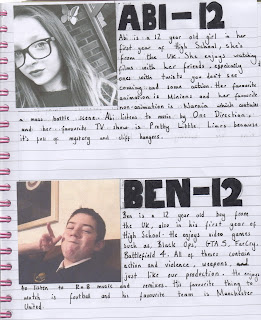
In the preliminary we had to have involved the 180-degree rule which is a cinematography guideline that states that two characters in a scene should maintain the same left/right relationship to one another, it allows the audience to visually connect with unseen movement happening around and behind the subject and it's important in the narration of battle scenes. Using the 180-degree rule and shot/reverse shot (where one character is shown looking at another character and then the other character is shown looking back at the first character) in the preliminary it showed me how using a vary of shots can help keep the audience and the scene interesting, compared to everything being just in one shot which is 100% more boring to watch. As I was the main editor for both the preliminary and the final production I saw how the camera positioning effected the lighting and the shots. I found that even if we were outside with natural lighting, if I went under any shelter the lighting was instantly darker but I didn't realise this when filming our preliminary until I edited it but this did help me make sure I was more careful with positioning when it came to filming our production.

Within our preliminary we also used a match on action shot which is a editing techniques where the editor cuts from one shot to another view that matches the first shots action. When editing I played around with this shot, changing the pace in which it was cut and it showed how the pace of just one shot can effect everything else which I definitly took into account when editing and filming the final production. Yet again it helped with how I should position the camera, I didn't realise I'd done it when we filmed the preliminary but we did the shot so that the person in it is walking out of the door to go outside and then the next shot is them walking across the frame outside, when planning for filming for the final product I made sure i made of note if the shot was outside or inside so that we didn't have a character walking outside but then being inside in the next shot.
The Final Production:
The final production took alot more planning then the preliminary task did as it had a lot more shots and editing involved in it. We filmed the final production over a course of three days due to weather problems and equipment issues but we managed to complete it.
During the preliminary there wasn't any fast paced scenes but as I've said I played around with the clips which did help with forming the one in the final production but I was able to use multiple different shots with different things happening in it, which ultimatly helped make that scene more intense and exciting. It also allowed me to use different shots I hadn't used in the preliminary or even before for example, a tracking shot which is where the camera follows the character, in our case by using a tripod to keep the shot and camera steady, the camera turns on an axis to follow the protagonist/victim's running feet which definietly looked better then the normal medium shot we'd filmed before.
Taking what I'd already learnt from using the 180-degree rule in the preliminary I was more confident when applying it to the final production, aswell as the match on action.
 With learning from the mistakes in positioning in the camera when doing the preliminary I avoiding placing the camera under any places with shades so that the lighting didn't suddenly get darker and we ended up with one shot dark and the other bright. Also, when we had a low angled shot I positioned the camera in the same place but just on a higher part of the location so that the background itself didn't dramatically changed but it was more effective then have the characters try to be smaller.
With learning from the mistakes in positioning in the camera when doing the preliminary I avoiding placing the camera under any places with shades so that the lighting didn't suddenly get darker and we ended up with one shot dark and the other bright. Also, when we had a low angled shot I positioned the camera in the same place but just on a higher part of the location so that the background itself didn't dramatically changed but it was more effective then have the characters try to be smaller.








